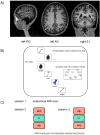Evidence of a Causal Role for mid-Ventrolateral Prefrontal Cortex Based Functional Networks in Retrieving High-Fidelity Memory
- PMID: 30291280
- PMCID: PMC6173692
- DOI: 10.1038/s41598-018-33164-w
Evidence of a Causal Role for mid-Ventrolateral Prefrontal Cortex Based Functional Networks in Retrieving High-Fidelity Memory
Abstract
Functional neuroimaging studies have implicated regions of both ventrolateral prefrontal cortex (VLPFC) and angular gyrus in processes associated with retrieving goal-relevant information, which increases the fidelity and richness of long-term memory (LTM). To further investigate the roles of these cortical regions as nodes in functional networks with memory regions of the medial temporal lobe (MTL), we used fMRI-guided, 1 Hz repetitive transcranial magnetic stimulation (rTMS) to perturb normal neuronal function. The aim was to test the causal roles of left mid-VLPFC and left angular gyrus (AG) in MTL-VLPFC-parietal networks that have been associated with high-fidelity memory retrieval. rTMS treatments were administered immediately before blocks in an old/new recognition test, which was based on a mnemonic similarity task requiring discrimination of previously studied pictures of common objects. Capability for mnemonic discrimination was evaluated after each of three conditions: placebo control (rTMS at somatosensory cortex), mid-VLPFC target (rTMS at left pars triangularis) and parietal target (rTMS at left AG). The results showed the effect of rTMS perturbation of mid-VLPFC diminished subsequent discrimination-based memory performance, relative to placebo control, and no significant effect of perturbation of AG. These findings show a causal role for functional networks with left mid-VLPFC in high-fidelity retrieval.
Conflict of interest statement
The authors declare no competing interests.
Figures


References
Publication types
MeSH terms
Grants and funding
- R00 AG043557/AG/NIA NIH HHS/United States
- R01 AG034613/AG/NIA NIH HHS/United States
- R00AG043557/U.S. Department of Health & Human Services | NIH | National Institute on Aging (U.S. National Institute on Aging)/International
- AG034613/U.S. Department of Health & Human Services | NIH | National Institute on Aging (U.S. National Institute on Aging)/International
LinkOut - more resources
Full Text Sources
Medical
Miscellaneous

